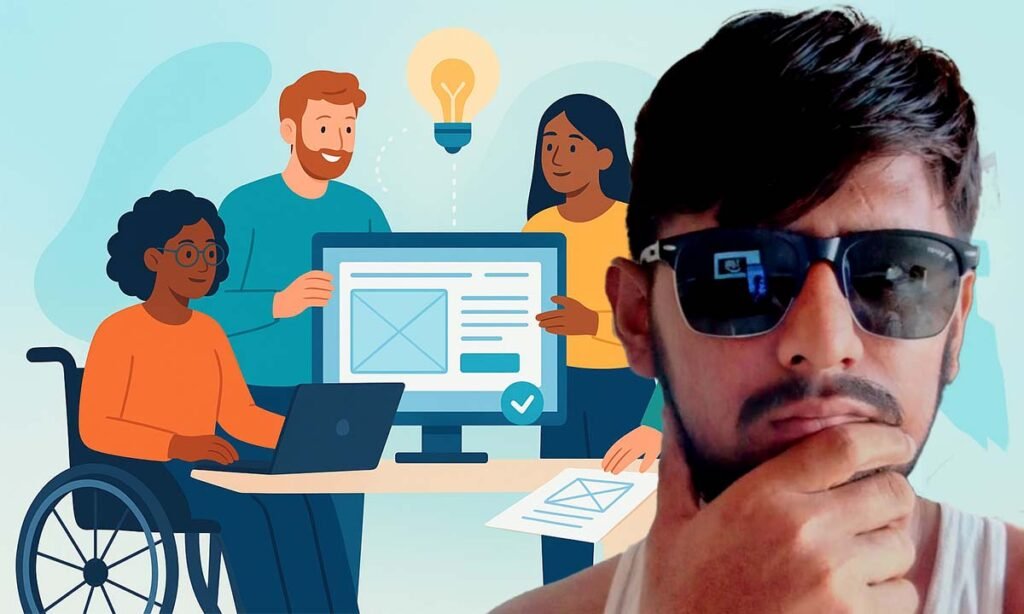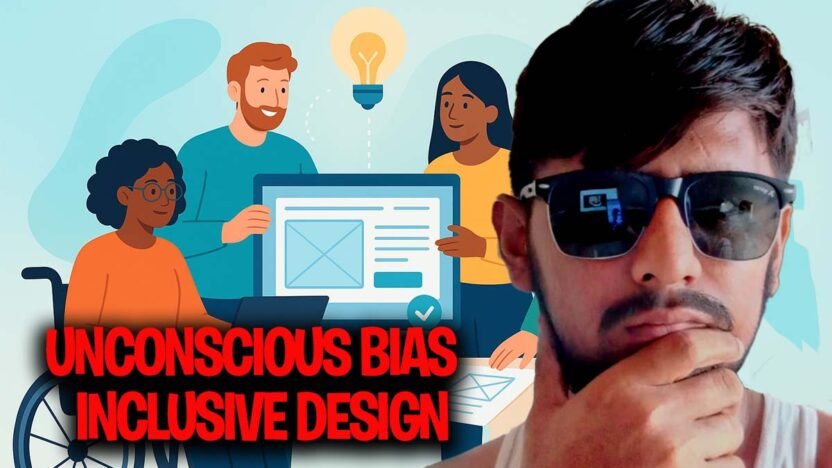Why Inclusive Design Matters for Everyone
Aap chahte ho products, websites aur services aise banao jo sabke liye kaam karein. Aap inclusive design me believe karte ho. Lekin kabhi kabhi, chahe aapki intention best ho, cheezein galat ho jaati hain.
Koi point out kar deta hai ki ek feature disabled logon ko exclude kar raha hai. Ya phir aapko baad me realize hota hai ki aapka product sirf ek specific background ke logon ke liye hi sahi kaam kar raha hai.
Aisa kyu hota hai? Bohot baar culprit hota hai ek aisi cheez jo aap dekh bhi nahi sakte — aapki unconscious bias.
The Purpose of This Article
Is article ka main purpose hai aapko samjhna dena ki unconscious biases hoti kya hain, ye kaise aapke kaam me ghus jaati hain aur sabse important, aap kaise inhe stop kar sakte ho taaki aapke products exclusive na ban jaayein.
Yahan aapke sawaalon ka jawab milega jaise “design me 6 main biases kaunse hote hain?” aur “inclusive leaders apni unconscious biases ko kaise handle karte hain?”
What Are Unconscious Biases?
Sabse pehle baat karte hain unconscious bias ki definition. Simple shabdon me, unconscious biases wo fast judgments aur stereotypes hote hain jo hum dusron ke baare me bina realise kiye bana lete hain.

Hamara brain aise shortcuts leta hai jo hamare background, culture aur personal experiences pe based hote hain. Yehi shortcuts unconscious biases kehlate hain.
Ye iska matlab nahi ki aap “bad” person ho. Har kisi me ye hote hain. Problem biases ka hona nahi hai, problem ye hai jab ye aapke design decisions ko bina aapko pata chale control karte hain.
How Do Unconscious Biases Form?
Ye form kaise hote hain? Hamara brain har jagah se information collect karta hai — upbringing, media, doston, society.
Dheere dheere ye sab ek tarah ki mental “files” create kar dete hain jo brain quick decision lene ke liye use karta hai. Isi tarah unconscious biases bante hain. Ye basically learned assumptions hote hain.
Why Is Inclusive Design Important?
Ab sawal aata hai ki inclusive design kyu zaruri hai? Simple words me, inclusive design ka matlab hai products aise design karna jo maximum log use kar sakein without kisi special adaptation ki zarurat.
Aur ye sirf disability tak limited nahi hai. Isme human diversity ke saare aspects consider kiye jaate hain — ability, language, culture, gender, age aur aur bhi differences.
Iska importance simple hai: good design matlab humane design. Jo sabko welcome kare. Aur business point of view se bhi smart hai — aapka product zyada bade audience tak reach karega.
6 Common Types of Unconscious Bias in Design
Toh ab aata hai main sawaal – design me 6 main types of biases kaunse hote hain? Ye basically wo mental shortcuts hain jo non-inclusive design ki taraf le jaate hain.
- Confirmation Bias: Jab aap sirf wahi information dhoondte ho jo aapke already beliefs ko confirm kare. Example: Aapko lagta hai “users ko ye feature pasand nahi aayega,” toh aap sirf unhi users se baat karte ho jo aapse agree karte hain, aur jo disagree karte hain unhe ignore kar dete ho.
- False Consensus Bias: Aapko lagta hai ki zyada log aapke opinion se agree karte hain, jabki reality me aisa nahi hota. Example: Ek designer jo tech expert hai, sochta hai ki sabko computer me right-click karna aata hai, par wo bhool jaata hai ki naye ya less tech-savvy users ko ye basic cheez bhi na pata ho.
- Primary Effect: Jab aap pehli cheez ko zyada importance dete ho jo aapne dekhi ya suni. Example: Brainstorming session me jo pehla idea aata hai usko hi full attention mil jaata hai aur baad ke better ideas ignore ho jaate hain.
- Affinity Bias: Hum naturally un logon ko prefer karte hain jo hamare jaison lagte hain ya sochte hain. Design me iska matlab hai aap apne jaison ke liye hi design banate ho. Example: Agar ek all-male team ek health app banati hai toh wo female health tracking features ko ignore kar sakti hai.
- Anchoring Bias: Jab aap pehli information (anchor) pe hi zyada depend kar lete ho. Example: Aapne sabse pehle ek competitor ka product dekha aur subconsciously usi ka layout ya features copy kar liye, chahe wo flawed hi kyu na ho, instead of apna better solution sochne ke.
- Social Conformity Bias: Jab aap apne judgement ki jagah bas group ke saath chalne lagte ho. Example: Team meeting me aap ek accessibility issue point out nahi karte kyunki baaki sabko wo problem lag hi nahi rahi hoti.
Consequences of Unconscious Bias in Design
Ab consequences dekhte hain – jab ye biases control le lete hain, toh design failures hote hain jo non-inclusive design ke examples ban jaate hain.
- Bad Graphic Design Example: Light grey text white background pe jo low vision wale log bilkul read nahi kar paate.
- Product Design Failure Example: Voice-activated smart speaker jo sirf standard American accent samajhta hai, aur dusre accents ya dialects ko fail kar deta hai. Ye unconscious bias ka classic tech example hai.
- Exclusive Design Example: Public bathroom jisme sirf steps hain aur wheelchair users ke liye koi access nahi hai. Ye clear exclusive design hai.
A Real-Life Example of Unconscious Bias
Meri apni ek experience hai – ek global client ke liye website banate waqt humne ek hand ka “OK” sign wali image use ki. Hume nahi pata tha ki duniya ke kai parts me ye gesture rude ya offensive maana jaata hai.
Humari unconscious bias ne assume kar liya ki hamara cultural norm universal hai. Ye chhoti si cheez thi, lekin isne hume ignorant dikhaya ek bade audience ke saamne. Ye unconscious bias ka ek classic example hai advertising aur marketing me.
How to Manage Unconscious Bias for Inclusive Design
Sirf bias ke baare me jaan lena enough nahi hai, usko handle karne ke liye ek proper plan bhi chahiye. Toh unconscious bias ko manage karne ka best way kya hai?
Step 1: Identify Your Biases
Sabse pehla step hai apne biases ko identify karna. Ye sabse mushkil part hota hai. Aapko apne decisions ke peeche curiosity rakhni hogi. Hamesha khud se poochho “kyu?”
Kyu maine ye user path sahi maana? Kyu maine ye image choose kiya? Aap online tools bhi use kar sakte ho jaise Harvard ka Implicit Association Test (IAT) jo hidden biases reveal kar deta hai.
Aur sabse important – honest feedback lo. Different backgrounds ke logon se apna kaam review karvao aur unki criticism ko openly accept karo.
Step 2: Foster Inclusive Leadership
Dusra step hai inclusive leadership ko foster karna. Leaders ko sabse pehle apni biases admit karni chahiye, isse team me safe space create hota hai jaha sab openly share kar sakein.
Inclusive leaders sirf diverse hiring nahi karte, balki unki baat sunte bhi hain. Wo “3 C’s” follow karte hain:
- Curiosity: Different perspectives samajhne ke liye questions poochna.
- Courage: Difficult conversations karna about exclusion.
- Cultural Intelligence: Actively dusri cultures aur experiences ke baare me seekhna.
Step 3: Implement Practical Techniques
Teesra step hai practical techniques implement karna.
- Personas banate waqt sirf ek generic user mat banao jaise “Sarah, 28, tech-savvy.” Balki alag abilities, ages aur backgrounds ko cover karo.
- User research inclusive banao – underrepresented groups ko include karo aur unke time ka respect karte hue unhe pay bhi karo.
- Har project ke liye accessibility checklists aur inclusive design guidelines follow karo taaki biased judgment ki jagah standard process ho.
- Aur ek aur important cheez – psychological safety. Junior members ya minority groups ko safe feel karna chahiye ki wo biases point out kar sakte hain bina kisi fear ke.
A Journey Toward Inclusive Design
Aur last me ek baat – ye ek journey hai, one-time task nahi. Isme humility chahiye, galat hone ki himmat chahiye, aur listening ki habit chahiye.
Goal perfect banna nahi hai, goal aware aur better banna hai. Ek aisa world build karna hai jaha design sabko include kare.
Take Action Today
Aaj se hi teen simple cheezein kar sakte ho:
- Ek Implicit Association Test lo aur apna ek hidden bias samjho.
- Apna koi old project review karo aur socho “is design ne kis group ko exclude kiya hoga?”
- Apni team ke saath is article pe baat karo. Awareness hi change ka pehla step hai.
Building a More Empathetic Future
Jab hum apne unconscious biases ko challenge karte hain, tab hum sirf better designers nahi bante, hum zyada empathetic human beings bante hain.
Aur wahi hoti hai truly great aur inclusive design ki foundation.





